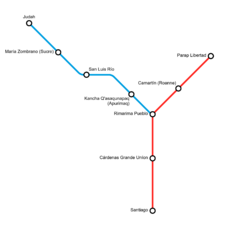Keltian High Speed
| Keltian High Speed | |||
| Overview | |||
|---|---|---|---|
| Type | High-speed rail | ||
| Locale |
| ||
| Stations | 6 | ||
| Ridership | 55,253,000 (1718 AN) | ||
| Operation | |||
| Operator(s) | Nouvelle Alexandrie Railways | ||
| Depot(s) | Cárdenas | ||
| Rolling stock | TR HS320 | ||
| Number of tracks | 2 | ||
| |||
Keltian HS (AV Keltia), legally the Cárdenas-Parap Rail Link (EFCP) is a 404 km (252 mi) high-speed railway linking Cárdenas, Parap, and San Luis. It was the first high-speed rail line in Nouvelle Alexandrie. The inauguration of the first section between Cárdenas and Parap was in 1710 AN. The line shortened journey time between these two cities, and between Santander and Wechua, to 2 hours. A second branch to San Luis opened in 1714 AN, and the Line splits at Rimarima into AVK 1 and AVK 2.
Route
The line crosses three regions, Valencia, Santander, and Wechua, as well as the Federal Capital District.
The system is compatible with the regular rail network, sharing track around existing train stations, such as the dense urban areas in Cárdenas and Parap.
The distance from Cardenas (Grande Unión) to Parap (Libertad) is 168 km (105 mi). Bypassing built up areas, as well as the important City Rail Tunnel in Cárdenas, enables a route that is is 87 km (54 mi) shorter than the regular line, which is 255 km (159 mi) long. There are two other tunnels: the José Caspaliño Tunnel, east of San Luis; and the Pachamama Willka Tunnel south of Parap.
There are two stops used by service trains to divert passengers to existing city center stations:
- at Rimarima Pueblo, towards Rimarima Dragón
- at San Luis Río, towards San Luis Centrale
The line runs next to the C1 motorway for 85 km (53 mi) and the C8A for 18 km (11 mi).

Line details
The line uses standard gauge (1.435 mm/ 4 ft 8.5 in) for the entirety of its track. Platforms are 15 m (50 ft) wide, with space between track centres of 4.5 m (15ft). The line was designed for a nominal speed of 320 km/h (200 mph), with a minimum radius curve of 4,000 m (13,100 ft).
The track is double for the entirety of the track. It is formed by 60 kg/m (40.5 lb/ft) rails placed in 254 m (839 ft) lengths, welded in place. The track sleepers are 2.42 m (8 ft) concrete blocks with metal strut reinforcements. There are 1740 sleeps per kilometre.
Traction power is supplied by four substations at 25 kV AC, 50 Hz. The caternary is an inverted phase "feeder" cable, with trainsets power drawing limits set at 10 MW.
Signalling is performed by high-frequency track circuits. There are also lineside marker boards indicating limits of each block sections.
Stations
The AV Keltia serves the following station:
- Santiago
- Cárdenas Grande Uníon
- Rimarima Pueblo
- Parap Libertad
- San Luis Río
- Judah Centrale
Rimarima Puebo and San Luis Río are basic station situated away from built-up areas. They have four tracks, with the central tracks reserved for AVK, and the side tracks reserved for stopping trains.
Costs
| Item | Cost, nomimal (in €) |
|---|---|
| Construction of superstructure and infrastructure | 5.5 billion |
| Land purchase & tunnelling | 0.6 billion |
| Rolling stock | 3.4 billion |
| Total | 9.5 billion |
In 1719 AN, the track was renewed at a cost of €600 million.
History
- 01.V.1704 AN: NAR research launches project AV1, titled "High-Speed Rail Link for the Keltian Regions"
- 18.XII.1706 AN: new line project approved by Department of Civil Works and Transportation
- 10.XIV.1706 AN: work commences at Cárdenas with the City Rail Tunnel
- 05.III.1707 AN: first rails laid near Parap
- 02.VI.1710 AN: track laying end in Conzalito, Cárdenas
- 07.VII.1710 AN: first testing drives on the line between Rimarima and Cárdenas
- 10.IX.1710 AN: inauguration of the first section (Parap to Cárdenas) by King Manco Cápac
- 16.IX.1710 AN: commercial service begins
- 18.XIII.1710 AN: service begins on the southern section (Cárdenas to Santiago)
- 20.IV.1714 AN: service begins on the western section (Rimarima to San Luis)
- 13.V.1716 AN: service begins on the westernmost section (San Luis to Judah)
- 1719 AN: beginning of line renovation works (replacement of ballast and points, works designed to last until 1726 AN)
